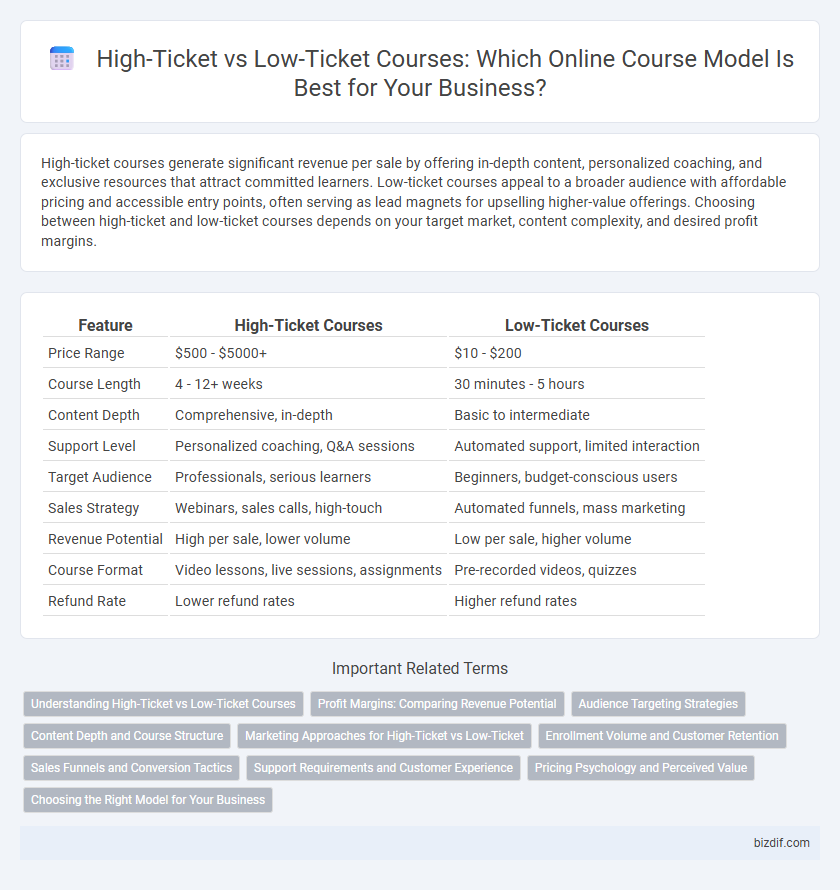High-ticket courses generate significant revenue per sale by offering in-depth content, personalized coaching, and exclusive resources that attract committed learners. Low-ticket courses appeal to a broader audience with affordable pricing and accessible entry points, often serving as lead magnets for upselling higher-value offerings. Choosing between high-ticket and low-ticket courses depends on your target market, content complexity, and desired profit margins.
Table of Comparison
| Feature | High-Ticket Courses | Low-Ticket Courses |
|---|---|---|
| Price Range | $500 - $5000+ | $10 - $200 |
| Course Length | 4 - 12+ weeks | 30 minutes - 5 hours |
| Content Depth | Comprehensive, in-depth | Basic to intermediate |
| Support Level | Personalized coaching, Q&A sessions | Automated support, limited interaction |
| Target Audience | Professionals, serious learners | Beginners, budget-conscious users |
| Sales Strategy | Webinars, sales calls, high-touch | Automated funnels, mass marketing |
| Revenue Potential | High per sale, lower volume | Low per sale, higher volume |
| Course Format | Video lessons, live sessions, assignments | Pre-recorded videos, quizzes |
| Refund Rate | Lower refund rates | Higher refund rates |
Understanding High-Ticket vs Low-Ticket Courses
High-ticket courses typically offer comprehensive, in-depth content paired with personalized support and exclusive access, targeting a niche audience willing to invest more for high value. Low-ticket courses focus on affordability and accessibility, delivering essential skills or knowledge with less customization and support, appealing to a broader market. Understanding the differences in pricing strategies, audience expectations, and course delivery methods is crucial for effective online course creation.
Profit Margins: Comparing Revenue Potential
High-ticket courses generate significantly higher profit margins per sale due to premium pricing, often ranging from $1,000 to $5,000 or more, attracting fewer but high-value clients. Low-ticket courses, priced between $50 and $300, rely on volume sales to achieve comparable revenue but face thinner profit margins per unit. Strategic pricing and targeted marketing are essential to maximize revenue potential in both models.
Audience Targeting Strategies
High-ticket courses appeal to niche audiences willing to invest in in-depth, personalized learning experiences, emphasizing quality over quantity in targeting strategies. Low-ticket courses rely on broad market appeal and volume sales, focusing on automated marketing funnels and wide-reaching social media campaigns. Effective audience targeting involves leveraging demographic data, buyer personas, and conversion analytics to align course pricing with the learner's perceived value and budget.
Content Depth and Course Structure
High-ticket courses typically offer in-depth content with comprehensive modules, tailored learning paths, and extensive resources, providing a thorough understanding of complex topics. Low-ticket courses often focus on concise, targeted lessons that cover foundational concepts and quick skills acquisition, with a simpler, more flexible structure. The course structure in high-ticket offerings usually includes interactive elements, personalized feedback, and detailed assessments, whereas low-ticket courses prioritize accessibility and efficiency.
Marketing Approaches for High-Ticket vs Low-Ticket
High-ticket courses require personalized marketing strategies, emphasizing value through detailed webinars, one-on-one consultations, and targeted email campaigns to justify the premium price. Low-ticket courses benefit from broad-reach tactics such as social media ads, influencer partnerships, and automated email sequences that drive volume sales. Understanding customer lifetime value and investing in relationship-building tools enhances conversion rates for high-ticket offerings, while scalable marketing funnels optimize revenue for low-ticket courses.
Enrollment Volume and Customer Retention
High-ticket courses typically attract fewer enrollments but generate higher revenue per student, making them ideal for intensive, personalized learning experiences with strong customer retention. Low-ticket courses achieve higher enrollment volumes due to affordability and accessibility, but often face lower retention rates and reduced lifetime value per customer. Balancing pricing strategy with course content and engagement tactics is crucial to optimize both enrollment and retention in online education.
Sales Funnels and Conversion Tactics
High-ticket courses demand tailored sales funnels emphasizing personalized engagement and trust-building through webinars, one-on-one consultations, and in-depth case studies to boost conversion rates. Low-ticket courses thrive with automated funnels using email sequences, discounts, and simple checkout processes to maximize volume and quick sales. Optimizing conversion tactics for each type involves analyzing customer journey touchpoints and leveraging targeted upsells or cross-sells relevant to course value.
Support Requirements and Customer Experience
High-ticket courses typically demand extensive support services, including personalized coaching, live Q&A sessions, and dedicated customer service, ensuring a premium customer experience. Low-ticket courses often rely on automated support like FAQs and community forums, offering a more self-guided learning journey but with limited direct interaction. Investing in robust support infrastructure for high-ticket courses enhances customer satisfaction and retention, whereas streamlined support keeps low-ticket courses scalable and cost-effective.
Pricing Psychology and Perceived Value
High-ticket courses leverage pricing psychology by signaling exclusivity, in-depth content, and personalized support, which elevates perceived value and attracts committed learners willing to invest significantly. Low-ticket courses emphasize affordability and accessibility, appealing to a broader audience but often perceived as less comprehensive or impactful. Understanding how price influences buyer expectations and course positioning is crucial for maximizing enrollment and satisfaction in online course creation.
Choosing the Right Model for Your Business
High-ticket courses generate substantial revenue through premium pricing, attracting committed learners willing to invest deeply in comprehensive content and personalized support. Low-ticket courses appeal to a broader audience with affordable pricing, maximizing enrollment volume but often requiring scalable content delivery and automated systems. Choosing the right model depends on your business goals, target market, and resources for content creation, marketing, and customer engagement.
High-ticket courses vs Low-ticket courses Infographic

 bizdif.com
bizdif.com